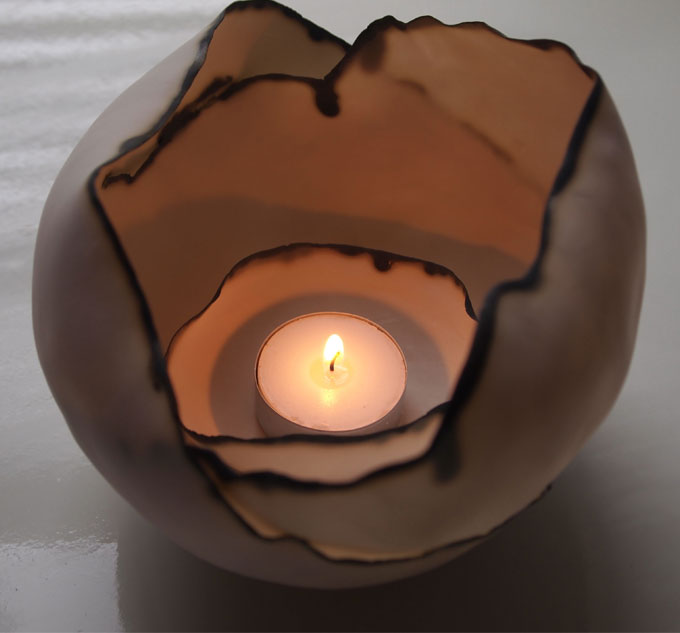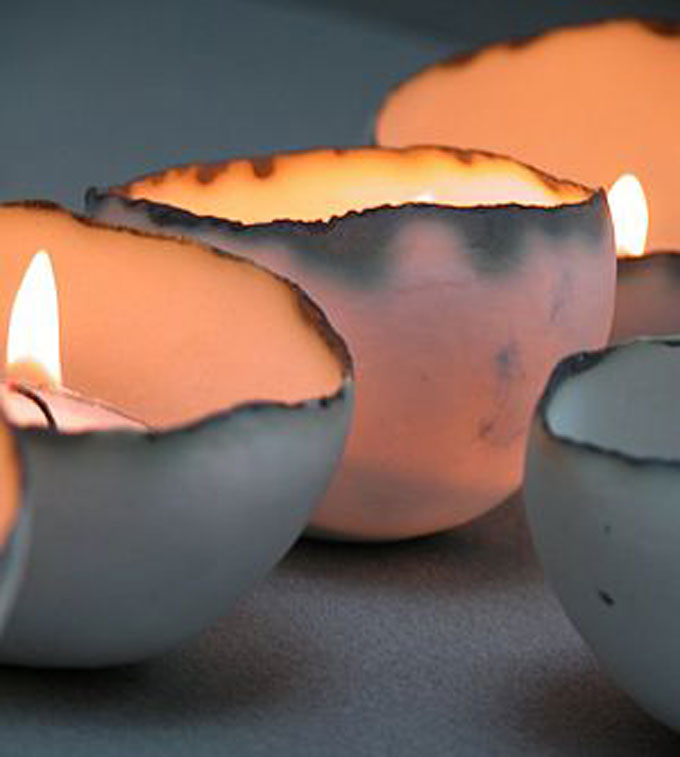Contrasting Clay
Last year, my friend Eimear gifted me three shell tealights from Sinead O’Moore. The trio lives on my mantle, and I enjoy the complexity of the pieces every time I pass. They seem so frail, almost on the verge of cracking, but the scorching elements that come from the firing also make them seem so sturdy, as if they could actually survive anything. I got the chance to interview O’Moore about her painstakingly beautiful work. I do hope you enjoy the description of her craft and thoughtful answers as much as I do.
danapop: I find your work a fantastic juxtaposition of being very delicate, yet rugged at the same time. Can you describe the process of making one of your pieces and the inspiration behind them?
Sinead O’Moore: Mainly I make two types of forms, small tealight shells & column vases with bends.
The tealight shells began life chunkier & cruder, initially made in earthenware. Once I started working with porcelain I began to investigate the material properties – strength & translucency. So working with the clay the aim was to see how far I could push the clay while still retaining strength. Using a mould to press a piece of porcelain in to, I then start pulling it away, working with my fingers until the porcelain is nearly skin thick and I can sense the mould through the material. Suctioning the form out of the mould while still very soft I then manipulate the form so they are irregular. Once they are dry I tidy the edges and biscuit fire them. After the first firing they are still very delicate and this is where I have my most breakages as I sand the outside before applying the oxide edge and re-fire to the high temperature firing. Finally I give them a final sand so they are smooth to touch on the outside.
By using my fingers and the clay body as opposed to a clay slip, the piece has naturally different thickness that creates a soft cloudy effect when lit by a tealight. Also there is individuality to each piece, which you would not achieve with a slip cast piece. The porcelain being so fine will bend and move in the high temperature firing. This can be seen clearer with the larger bowls. To make these I use a wooden tool to peel back the porcelain, so I need to listen as well as use the sense of touch, before I tear through the porcelain and have to start again. These are more organic as the slight curve I add while they are soft will move and exaggerate with the temperature in the kiln. On the final firing what I put in the kiln may be completely different to what I take out. These larger bowls have developed further by joining two/three bowls when they are semi soft clay, playing with how they move in the kiln and then how the light glows through the porcelain. Ideally they should evoke a sense of fragility while being strong in comparison to their thickness.
In the small tealight shells range I also use white earthenware, this gives a different look and feel. The material is solid, no lights glows through. Using the earthenware allows me to use low temperature firing crystalline glazes, which are a high gloss finish. I apply the glaze to the inside rather than outside & sand the raw clay body with a fine glass sand paper to produce a smooth tactile surface to the outside.
The vases are the other forms I make. Predominately I worked in porcelain, as I love the feel of the material and the beauty of the natural clay body. While making some straight cylindrical vases with strong lines etched into the surface, I decided to see how the lines would change with the form if I altered the form by adding bends and folds. Porcelain is not a very forgiving material, if you wait too long to add the bends it will crack along the stress lines, too soon and they slump. Also putting too extreme a bend they will topple in the firing. So it really is the case of respecting your material and working with it rather than against it. I sometime make the vases in a rough stoneware “crank” material, this is playing with the contrast of the materials, how similar forms vary visually and touch by the use of the base material.
Adding the copper oxide to the single lined vases highlights the lines while contrasting with the clay body. Over time I have been refining them, making the bends “softer”, adding in a “plinth” type base section, sanding the surface between firings and after the final firing to the top part of the vase while leaving the bottom section as is. My thoughts are ceramics should be tactile; you should want to touch them. Having different textures in the form adds to the piece in a sensory sense, I hope. I can generally see/feel the mood I was in when I made each piece/group.
I suppose throughout my work there is a split personality. Strength v’s Fragility, Refinement v’s Raw, Rough v’s Smooth, Respecting the material while pushing it to its finest limit. Constantly I am looking to see how to develop my pieces, making little changes and adapting them.
danapop: In today’s world of Internet shopping, which markets your product around the globe, how do you stay true to yourself as an artist creating individual pieces from your own hands while keeping up with the demand of getting your work to the masses?
O’Moore: This is a very timely question, as it is an ongoing question I ask myself and I am certain it is a question many makers battle with.
Putting a business head on, the answer of keeping up with the demand of getting your work to the masses is to either employ someone to help with the making, or outsource some of the making to manufactures. This might make it more viable to run as a business if I want to meet the masses at the cost they are now. Some ceramicists produce two ranges, the manufactured version of their designs and the handmade side. The two different ranges are priced accordingly.
If I think as a craftsperson/artist, I make ceramics because I love working with clay. I do not want to lose contact with the clay or have my pieces lose their integrity, which is a fear if I go down the manufacturing route, which will alienate some customers. At present, I sell to beautiful small shops and galleries where people who buy the bowls appreciate the handmade and their individuality. The online business is still predominantly UK based, where people have come across my work elsewhere and approach me then via the Internet. So I think the answer might be not to aim to over take the world with little tealight bowls and look at how to progress while retaining myself as the maker/artist of a strong small business.
Images: Courtesy of the artist










